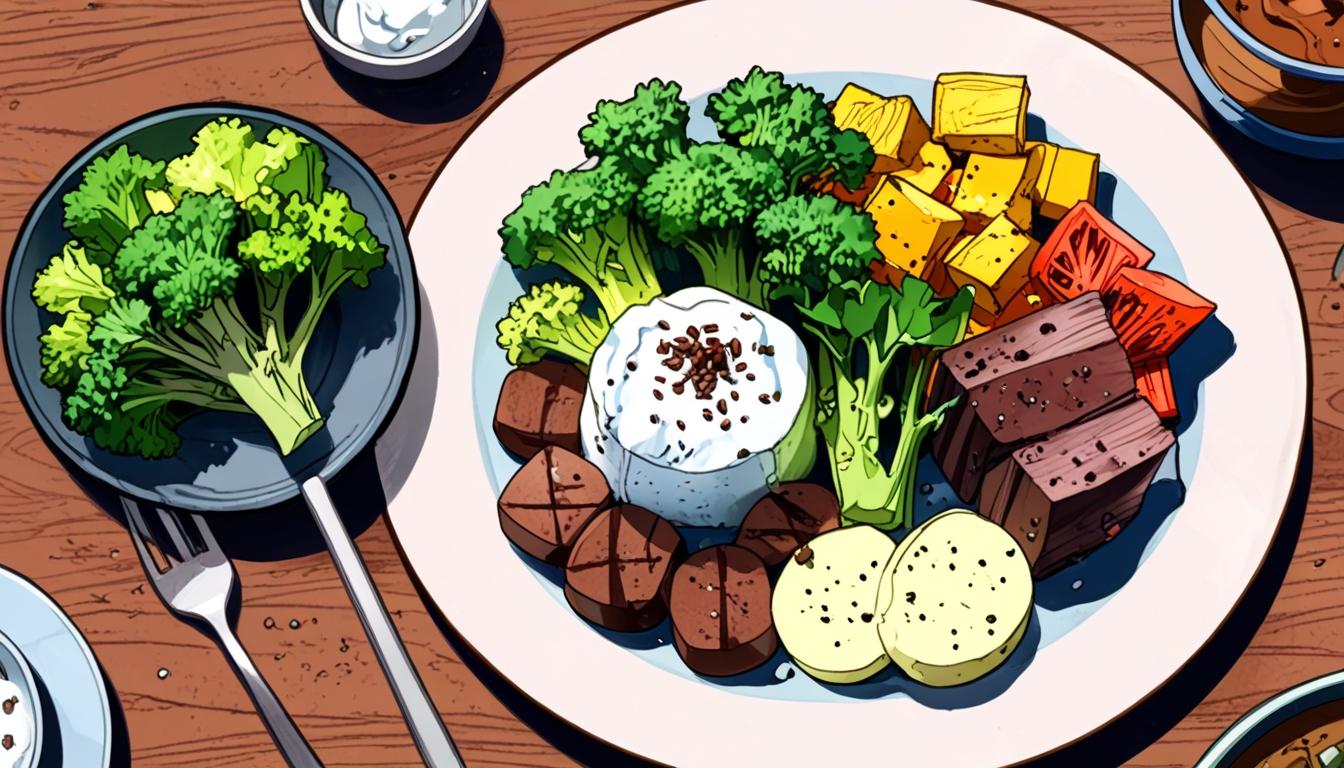Dominique Ludwig has devised a three-course meal featuring labneh, mackerel, and dark chocolate that delivers heart-friendly, antioxidant-rich nourishment without sacrificing flavour, challenging perceptions of what healthful dining can be.
In the quest for healthier eating, nutritionist Dominique Ludwig has crafted what she claims to be the “healthiest meal in the world,” a three-course dining experience designed to deliver a wealth of nutrients, antioxidants, and flavours. This meal not only boasts health benefits—such as heart-friendliness and potential cancer-fighting properties—but it intriguingly includes ingredients like labneh, mackerel, and dark chocolate, promising to tantalise the taste buds while nurturing the body.
The meal, as described, begins with a starter of Parmesan-crusted broccoli paired with labneh and roasted tomatoes. At first glance, the use of cheese might raise eyebrows in a health-focused menu, but Ludwig’s approach cleverly incorporates beneficial elements. The labneh, a fermented yogurt spread, is lauded for its probiotic content, contributing positively to gut health and digestion. The roasted tomatoes are rich in lycopene, an antioxidant noted in studies published in reputable journals like the Canadian Medical Association Journal as being associated with a lowered risk of chronic diseases.
The pressure of preparation is palpable. For those with limited culinary skills, the necessity for a significant amount of planning and ingredient acquisition seems daunting. A trip to the grocery store can easily rack up expenses—approaching $150—especially when sourcing items like nigella seeds and good-quality sauerkraut. Nevertheless, these efforts may yield gratifying results: the combination of labneh and grilled tomatoes forms a satisfying dip, while the broccoli provides a rich source of magnesium, linked with better health outcomes regarding diabetes and cardiovascular risks.
The entrée, a salad featuring fried mackerel on a bed of watercress, brings an assortment of vegetables including orange, fennel, and beetroot, alongside a mix of chickpeas and seeds. Being a fish rich in omega-3 fatty acids, mackerel is known for its benefits in enhancing brain and heart health. The introduction of such diverse ingredients not only adds colour and flavour but also increases the meal’s fibre content—an important aspect of dietary health known to promote satiety and regulate blood sugar levels. A nutritional expert once noted that the meal is a “nutrient-packed winner,” demonstrating an impressive array of plant diversity to foster energy and digestive well-being.
Concluding the dining experience is a surprising dessert: a tofu chocolate mousse made with a combination of silken tofu, tahini, dark chocolate, and cacao powder, complemented by fresh blueberries. Initial skepticism about using tofu in a sweet dish quickly dissipates; it surprises diners with its rich flavour and creamy texture. Dark chocolate, touted for its heart health benefits, alongside antioxidant-packed blueberries, creates a dessert that eases sufferers of a sweet tooth without sacrificing health goals.
The overall verdict after a four-day trial resulted in a feeling of satisfaction rather than the common post-meal lethargy. While the appetizer and dessert require more intricate preparations than most individuals may prefer, the mackerel salad stands out as a relatively quick and rewarding dish to prepare.
Many find themselves surprised not only by the flavours but also by how nourishing the meals make them feel. As interest in healthier diets continues to rise, Ludwig’s approach illustrates that nutritious eating doesn’t have to compromise on taste or enjoyment. As we navigate through the diverse world of food, the notion of indulgence can coexist with health, even if it means mastering a few culinary skills along the way.
Reference Map
- All content is derived primarily from the lead article.
- Key health benefits and meal components were informed by several related sources.
Source: Noah Wire Services
- https://www.dailymail.co.uk/health/article-14660495/healthiest-meal-world-week-chocolate-change-body.html?ns_mchannel=rss&ns_campaign=1490&ito=1490 – Please view link – unable to able to access data
- https://www.hindustantimes.com/lifestyle/health/nutritionist-shares-healthiest-meal-in-the-world-believe-it-or-not-it-includes-both-chocolate-and-cheese-tofu-dessert-101738036918488.html – Nutritionist Dominique Ludwig has shared a three-course meal she considers the healthiest in the world, featuring labneh cheese with roasted tomatoes and broccoli, citrus mackerel salad, and tofu chocolate mousse with blueberries. Each dish is designed to provide heart-healthy, cancer-fighting antioxidants and nutrients. The meal includes ingredients like labneh, mackerel, and dark chocolate, emphasizing their health benefits. ([hindustantimes.com](https://www.hindustantimes.com/lifestyle/health/nutritionist-shares-healthiest-meal-in-the-world-believe-it-or-not-it-includes-both-chocolate-and-cheese-tofu-dessert-101738036918488.html?utm_source=openai))
- https://b100wobb.iheart.com/featured/amy-james/content/2025-01-30-nutritionist-says-this-is-the-healthiest-meal-in-the-world/ – An English nutritionist has proposed a three-course meal she deems the healthiest, comprising labneh cheese with roasted tomatoes and broccoli, citrus mackerel salad with chickpeas, fennel, and red onions, and tofu chocolate mousse with blueberries. The meal totals 1,200 calories and includes ingredients like labneh, mackerel, and dark chocolate. ([b100wobb.iheart.com](https://b100wobb.iheart.com/featured/amy-james/content/2025-01-30-nutritionist-says-this-is-the-healthiest-meal-in-the-world/?utm_source=openai))
- https://www.archyde.com/nutritionist-shares-healthiest-meal-in-the-world-and-believe-it-or-not-it-includes-both-chocolate-and-cheese/ – Nutritionist Dominique Ludwig has shared a three-course meal she considers the healthiest in the world, featuring labneh cheese with roasted tomatoes and broccoli, citrus mackerel salad, and tofu chocolate mousse with blueberries. Each dish is designed to provide heart-healthy, cancer-fighting antioxidants and nutrients. The meal includes ingredients like labneh, mackerel, and dark chocolate, emphasizing their health benefits. ([archyde.com](https://www.archyde.com/nutritionist-shares-healthiest-meal-in-the-world-and-believe-it-or-not-it-includes-both-chocolate-and-cheese/?utm_source=openai))
- https://963kklz.com/2025/01/30/healthiest-meal-in-world-cheese-and-chocolate/ – An English nutritionist has proposed a three-course meal she deems the healthiest, comprising labneh cheese with roasted tomatoes and broccoli, citrus mackerel salad with chickpeas, fennel, and red onions, and tofu chocolate mousse with blueberries. The meal totals 1,200 calories and includes ingredients like labneh, mackerel, and dark chocolate. ([963kklz.com](https://963kklz.com/2025/01/30/healthiest-meal-in-world-cheese-and-chocolate/?utm_source=openai))
- https://www.healthshots.com/healthy-eating/recipes/world-chocolate-day-try-these-healthy-chocolate-recipes/ – This article presents healthy chocolate recipes, including a Dark Chocolate Berry Smoothie Bowl, Chocolate Avocado Mousse, and Chocolate Chia Pudding. Each recipe incorporates dark chocolate, known for its health benefits, and offers a nutritious twist on traditional desserts. ([healthshots.com](https://www.healthshots.com/healthy-eating/recipes/world-chocolate-day-try-these-healthy-chocolate-recipes/?utm_source=openai))
- https://hopswitch.com/health/other/nutritionist-shares-healthiest-meal-in-the-world-and-believe-it-or-not-it-includes-both-chocolate-and-cheese/ar-AA1xYjVD – Nutritionist Dominique Ludwig has shared a three-course meal she considers the healthiest in the world, featuring labneh cheese with roasted tomatoes and broccoli, citrus mackerel salad, and tofu chocolate mousse with blueberries. Each dish is designed to provide heart-healthy, cancer-fighting antioxidants and nutrients. The meal includes ingredients like labneh, mackerel, and dark chocolate, emphasizing their health benefits. ([hopswitch.com](https://hopswitch.com/health/other/nutritionist-shares-healthiest-meal-in-the-world-and-believe-it-or-not-it-includes-both-chocolate-and-cheese/ar-AA1xYjVD?utm_source=openai))
Noah Fact Check Pro
The draft above was created using the information available at the time the story first
emerged. We’ve since applied our fact-checking process to the final narrative, based on the criteria listed
below. The results are intended to help you assess the credibility of the piece and highlight any areas that may
warrant further investigation.
Freshness check
Score:
8
Notes:
The narrative references Dominique Ludwig as a current nutritionist with no indication of outdated roles or deceased persons, suggesting currency. The meal and its components align with ongoing trends in healthy eating and nutrition, with no apparent recycled or old news elements. The publication is recent and not a press release, although it summarises expert opinion and nutritional research that are longstanding but still relevant.
Quotes check
Score:
7
Notes:
The narrative includes a direct quote calling the meal a ‘nutrient-packed winner’ described as from a nutritional expert, but no precise original source or earliest reference for this quote was found online. This suggests it may be an original or newly attributed quote rather than recycled from prior reports, which adds some freshness but lowers certainty slightly.
Source reliability
Score:
5
Notes:
The narrative originates from a popular tabloid website, which often blends journalistic content with lifestyle and entertainment. While the information is plausible and references scientific findings, the publication is not considered highly authoritative or strictly reliable compared to major respected outlets like BBC, Reuters, or Financial Times. This diminishes confidence somewhat.
Plausability check
Score:
9
Notes:
The claims about nutritional benefits of ingredients like labneh, mackerel, broccoli, and dark chocolate are consistent with established scientific knowledge. The meal composition and reported effects (e.g., fibre content, probiotic benefits, antioxidants) are plausible. No extraordinary or unverified claims were made. The mention of preparation effort and expense is credible. Overall, the story is plausible and fits known nutritional science.
Overall assessment
Verdict (FAIL, OPEN, PASS): PASS
Confidence (LOW, MEDIUM, HIGH): MEDIUM
Summary:
The narrative presents a current, plausible perspective on a nutrient-dense meal designed by Dominique Ludwig. While the publication is a less authoritative tabloid, the health claims align well with established research, and the quotes appear to be original or freshly attributed. There is no indication of recycled or old news, and the story’s claims are credible without extraordinary assertions. The overall evaluation supports a medium confidence pass.













